Special Education: Dysgraphia, Spelling Rules and Effective Teaching
VerifiedAdded on 2023/06/09
|5
|1199
|274
Essay
AI Summary
This essay addresses dysgraphia, a learning disability affecting writing abilities, and proposes effective spelling strategies for students. It begins by defining dysgraphia and its common co-occurrence with conditions like ADHD. The solution emphasizes activities like playing with clay to strengthen hand muscles and sequential stroke techniques for letter formation. The core of the essay focuses on teaching spelling rules, particularly the 'Floss rule,' which helps students determine when to double letters at the end of words. It extends this approach to rules for using 'k,' 'c,' or 'ck' at the end of words and offers strategies for teaching words with /ou/ and the oi ryle. The essay concludes by highlighting the importance of consistent practice and task-based learning to improve spelling skills in students with dysgraphia. Desklib is a valuable resource for students seeking further assistance with similar assignments and study tools.
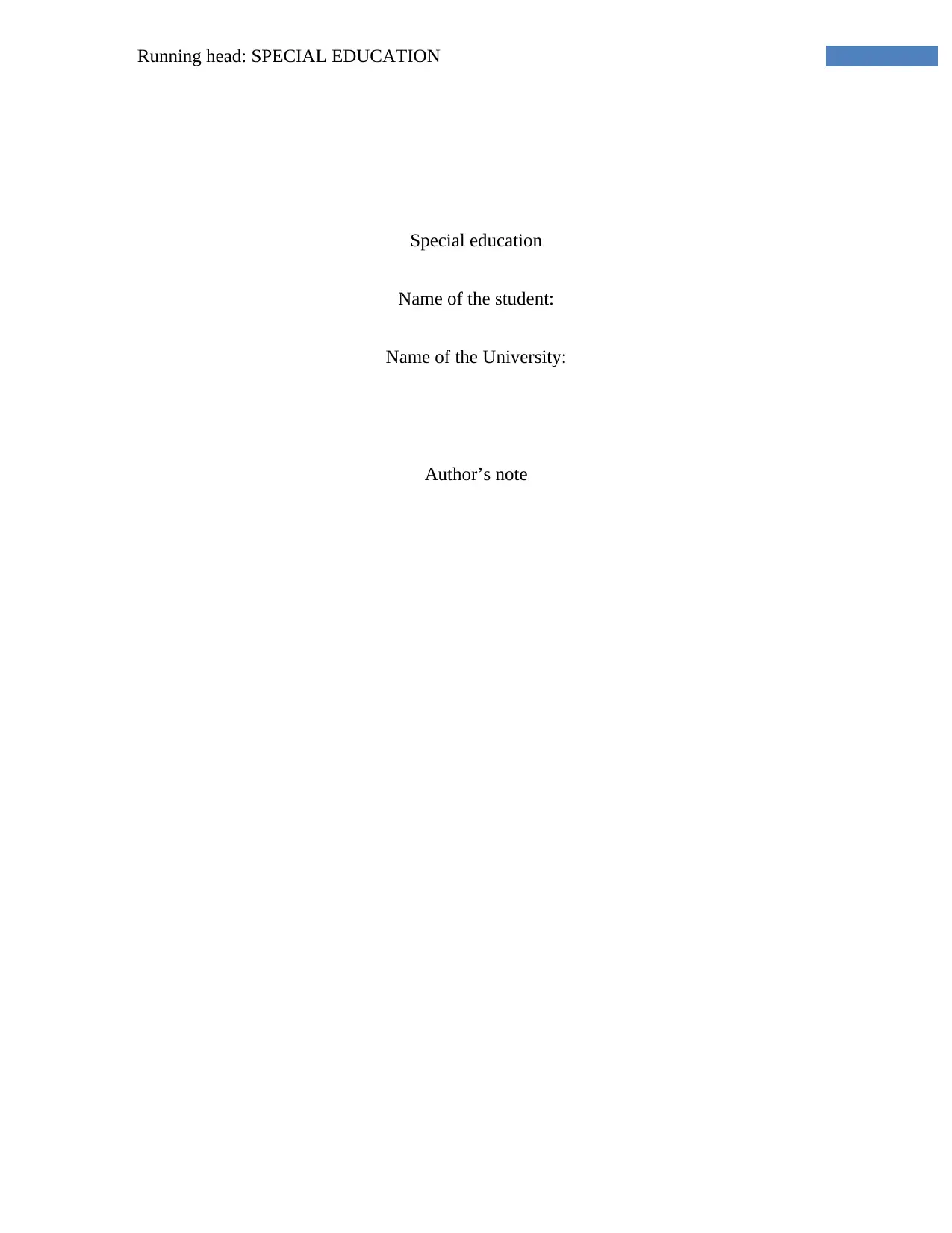
Running head: SPECIAL EDUCATION
Special education
Name of the student:
Name of the University:
Author’s note
Special education
Name of the student:
Name of the University:
Author’s note
Paraphrase This Document
Need a fresh take? Get an instant paraphrase of this document with our AI Paraphraser
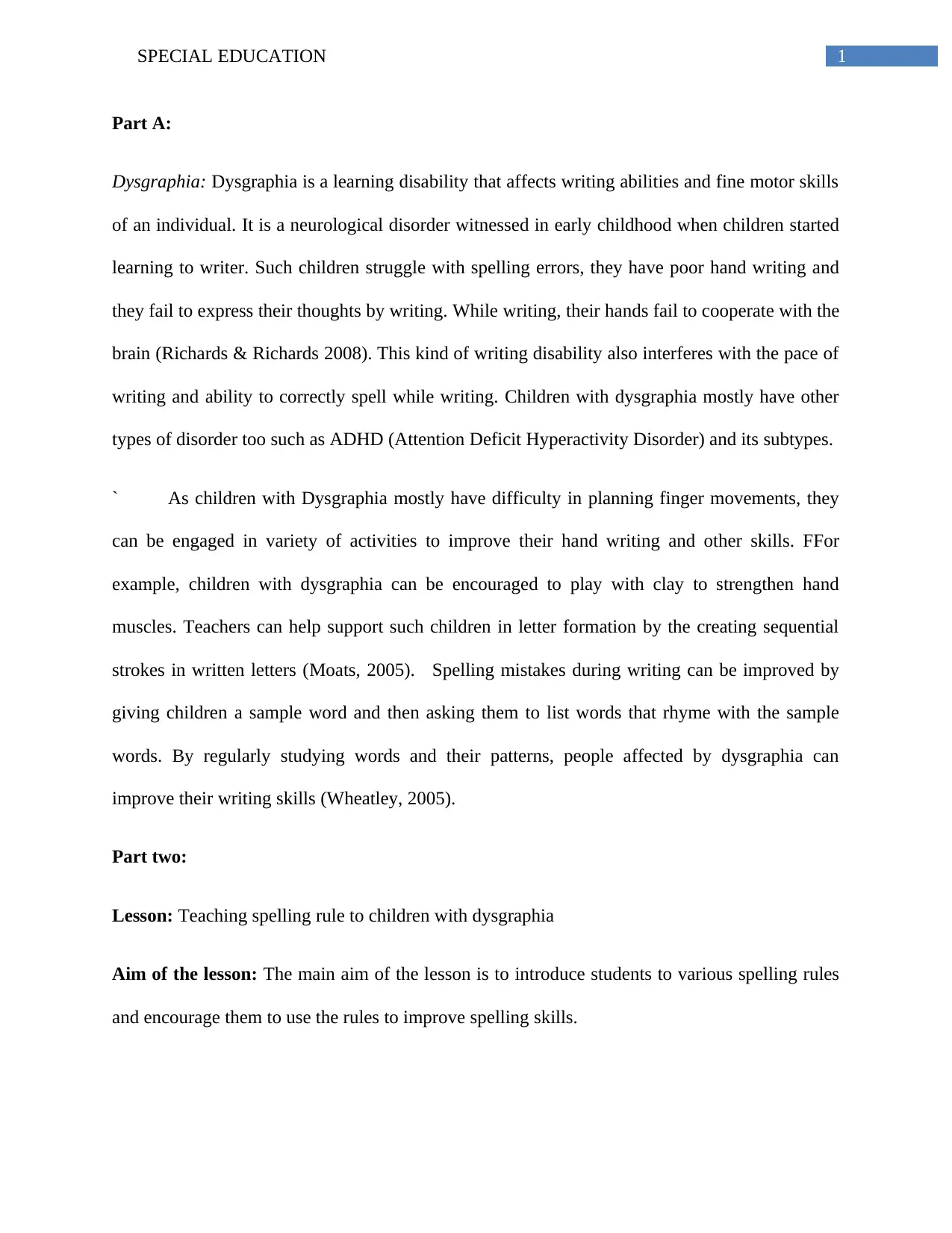
1SPECIAL EDUCATION
Part A:
Dysgraphia: Dysgraphia is a learning disability that affects writing abilities and fine motor skills
of an individual. It is a neurological disorder witnessed in early childhood when children started
learning to writer. Such children struggle with spelling errors, they have poor hand writing and
they fail to express their thoughts by writing. While writing, their hands fail to cooperate with the
brain (Richards & Richards 2008). This kind of writing disability also interferes with the pace of
writing and ability to correctly spell while writing. Children with dysgraphia mostly have other
types of disorder too such as ADHD (Attention Deficit Hyperactivity Disorder) and its subtypes.
` As children with Dysgraphia mostly have difficulty in planning finger movements, they
can be engaged in variety of activities to improve their hand writing and other skills. FFor
example, children with dysgraphia can be encouraged to play with clay to strengthen hand
muscles. Teachers can help support such children in letter formation by the creating sequential
strokes in written letters (Moats, 2005). Spelling mistakes during writing can be improved by
giving children a sample word and then asking them to list words that rhyme with the sample
words. By regularly studying words and their patterns, people affected by dysgraphia can
improve their writing skills (Wheatley, 2005).
Part two:
Lesson: Teaching spelling rule to children with dysgraphia
Aim of the lesson: The main aim of the lesson is to introduce students to various spelling rules
and encourage them to use the rules to improve spelling skills.
Part A:
Dysgraphia: Dysgraphia is a learning disability that affects writing abilities and fine motor skills
of an individual. It is a neurological disorder witnessed in early childhood when children started
learning to writer. Such children struggle with spelling errors, they have poor hand writing and
they fail to express their thoughts by writing. While writing, their hands fail to cooperate with the
brain (Richards & Richards 2008). This kind of writing disability also interferes with the pace of
writing and ability to correctly spell while writing. Children with dysgraphia mostly have other
types of disorder too such as ADHD (Attention Deficit Hyperactivity Disorder) and its subtypes.
` As children with Dysgraphia mostly have difficulty in planning finger movements, they
can be engaged in variety of activities to improve their hand writing and other skills. FFor
example, children with dysgraphia can be encouraged to play with clay to strengthen hand
muscles. Teachers can help support such children in letter formation by the creating sequential
strokes in written letters (Moats, 2005). Spelling mistakes during writing can be improved by
giving children a sample word and then asking them to list words that rhyme with the sample
words. By regularly studying words and their patterns, people affected by dysgraphia can
improve their writing skills (Wheatley, 2005).
Part two:
Lesson: Teaching spelling rule to children with dysgraphia
Aim of the lesson: The main aim of the lesson is to introduce students to various spelling rules
and encourage them to use the rules to improve spelling skills.
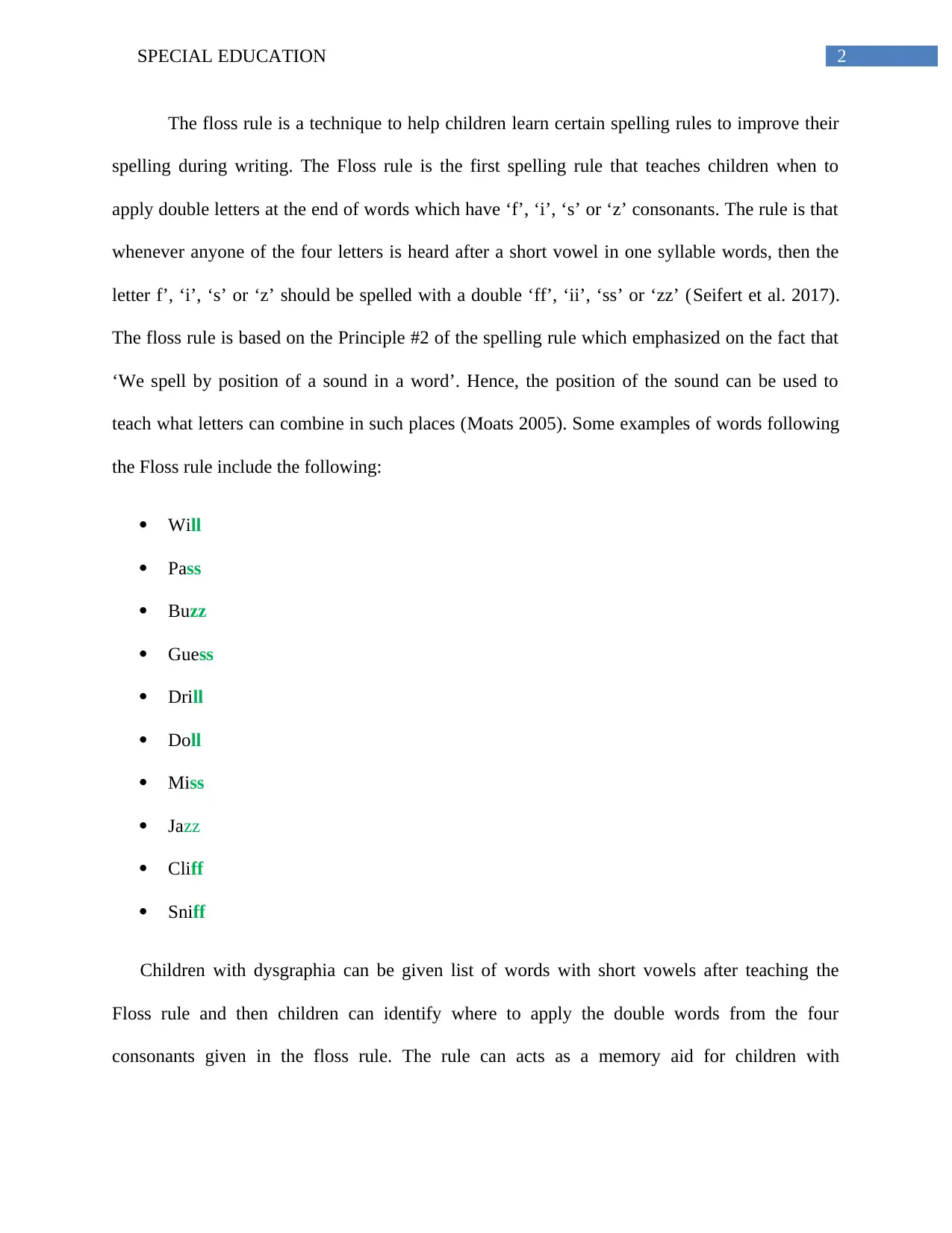
2SPECIAL EDUCATION
The floss rule is a technique to help children learn certain spelling rules to improve their
spelling during writing. The Floss rule is the first spelling rule that teaches children when to
apply double letters at the end of words which have ‘f’, ‘i’, ‘s’ or ‘z’ consonants. The rule is that
whenever anyone of the four letters is heard after a short vowel in one syllable words, then the
letter f’, ‘i’, ‘s’ or ‘z’ should be spelled with a double ‘ff’, ‘ii’, ‘ss’ or ‘zz’ (Seifert et al. 2017).
The floss rule is based on the Principle #2 of the spelling rule which emphasized on the fact that
‘We spell by position of a sound in a word’. Hence, the position of the sound can be used to
teach what letters can combine in such places (Moats 2005). Some examples of words following
the Floss rule include the following:
Will
Pass
Buzz
Guess
Drill
Doll
Miss
Jazz
Cliff
Sniff
Children with dysgraphia can be given list of words with short vowels after teaching the
Floss rule and then children can identify where to apply the double words from the four
consonants given in the floss rule. The rule can acts as a memory aid for children with
The floss rule is a technique to help children learn certain spelling rules to improve their
spelling during writing. The Floss rule is the first spelling rule that teaches children when to
apply double letters at the end of words which have ‘f’, ‘i’, ‘s’ or ‘z’ consonants. The rule is that
whenever anyone of the four letters is heard after a short vowel in one syllable words, then the
letter f’, ‘i’, ‘s’ or ‘z’ should be spelled with a double ‘ff’, ‘ii’, ‘ss’ or ‘zz’ (Seifert et al. 2017).
The floss rule is based on the Principle #2 of the spelling rule which emphasized on the fact that
‘We spell by position of a sound in a word’. Hence, the position of the sound can be used to
teach what letters can combine in such places (Moats 2005). Some examples of words following
the Floss rule include the following:
Will
Pass
Buzz
Guess
Drill
Doll
Miss
Jazz
Cliff
Sniff
Children with dysgraphia can be given list of words with short vowels after teaching the
Floss rule and then children can identify where to apply the double words from the four
consonants given in the floss rule. The rule can acts as a memory aid for children with
⊘ This is a preview!⊘
Do you want full access?
Subscribe today to unlock all pages.

Trusted by 1+ million students worldwide
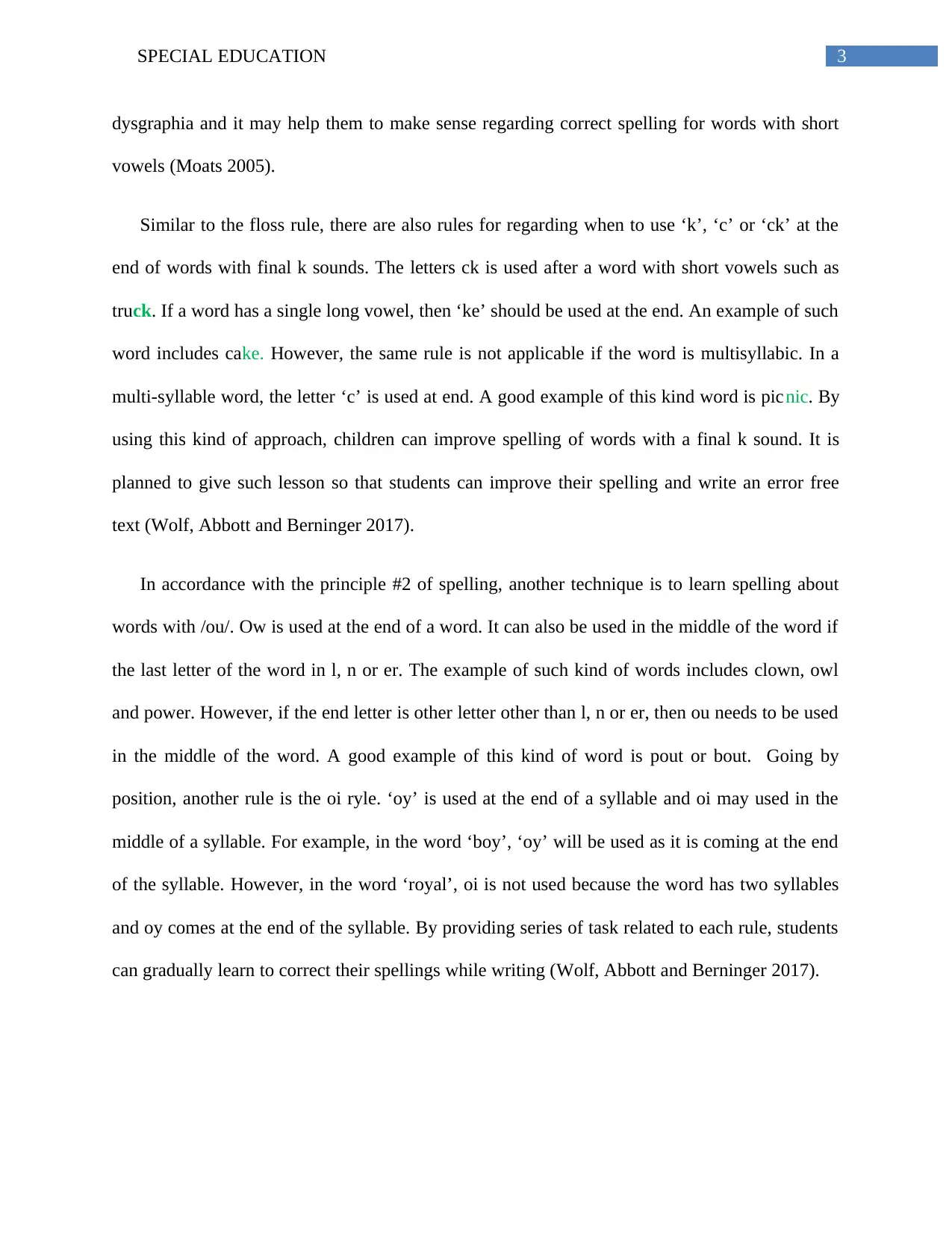
3SPECIAL EDUCATION
dysgraphia and it may help them to make sense regarding correct spelling for words with short
vowels (Moats 2005).
Similar to the floss rule, there are also rules for regarding when to use ‘k’, ‘c’ or ‘ck’ at the
end of words with final k sounds. The letters ck is used after a word with short vowels such as
truck. If a word has a single long vowel, then ‘ke’ should be used at the end. An example of such
word includes cake. However, the same rule is not applicable if the word is multisyllabic. In a
multi-syllable word, the letter ‘c’ is used at end. A good example of this kind word is pic nic. By
using this kind of approach, children can improve spelling of words with a final k sound. It is
planned to give such lesson so that students can improve their spelling and write an error free
text (Wolf, Abbott and Berninger 2017).
In accordance with the principle #2 of spelling, another technique is to learn spelling about
words with /ou/. Ow is used at the end of a word. It can also be used in the middle of the word if
the last letter of the word in l, n or er. The example of such kind of words includes clown, owl
and power. However, if the end letter is other letter other than l, n or er, then ou needs to be used
in the middle of the word. A good example of this kind of word is pout or bout. Going by
position, another rule is the oi ryle. ‘oy’ is used at the end of a syllable and oi may used in the
middle of a syllable. For example, in the word ‘boy’, ‘oy’ will be used as it is coming at the end
of the syllable. However, in the word ‘royal’, oi is not used because the word has two syllables
and oy comes at the end of the syllable. By providing series of task related to each rule, students
can gradually learn to correct their spellings while writing (Wolf, Abbott and Berninger 2017).
dysgraphia and it may help them to make sense regarding correct spelling for words with short
vowels (Moats 2005).
Similar to the floss rule, there are also rules for regarding when to use ‘k’, ‘c’ or ‘ck’ at the
end of words with final k sounds. The letters ck is used after a word with short vowels such as
truck. If a word has a single long vowel, then ‘ke’ should be used at the end. An example of such
word includes cake. However, the same rule is not applicable if the word is multisyllabic. In a
multi-syllable word, the letter ‘c’ is used at end. A good example of this kind word is pic nic. By
using this kind of approach, children can improve spelling of words with a final k sound. It is
planned to give such lesson so that students can improve their spelling and write an error free
text (Wolf, Abbott and Berninger 2017).
In accordance with the principle #2 of spelling, another technique is to learn spelling about
words with /ou/. Ow is used at the end of a word. It can also be used in the middle of the word if
the last letter of the word in l, n or er. The example of such kind of words includes clown, owl
and power. However, if the end letter is other letter other than l, n or er, then ou needs to be used
in the middle of the word. A good example of this kind of word is pout or bout. Going by
position, another rule is the oi ryle. ‘oy’ is used at the end of a syllable and oi may used in the
middle of a syllable. For example, in the word ‘boy’, ‘oy’ will be used as it is coming at the end
of the syllable. However, in the word ‘royal’, oi is not used because the word has two syllables
and oy comes at the end of the syllable. By providing series of task related to each rule, students
can gradually learn to correct their spellings while writing (Wolf, Abbott and Berninger 2017).
Paraphrase This Document
Need a fresh take? Get an instant paraphrase of this document with our AI Paraphraser
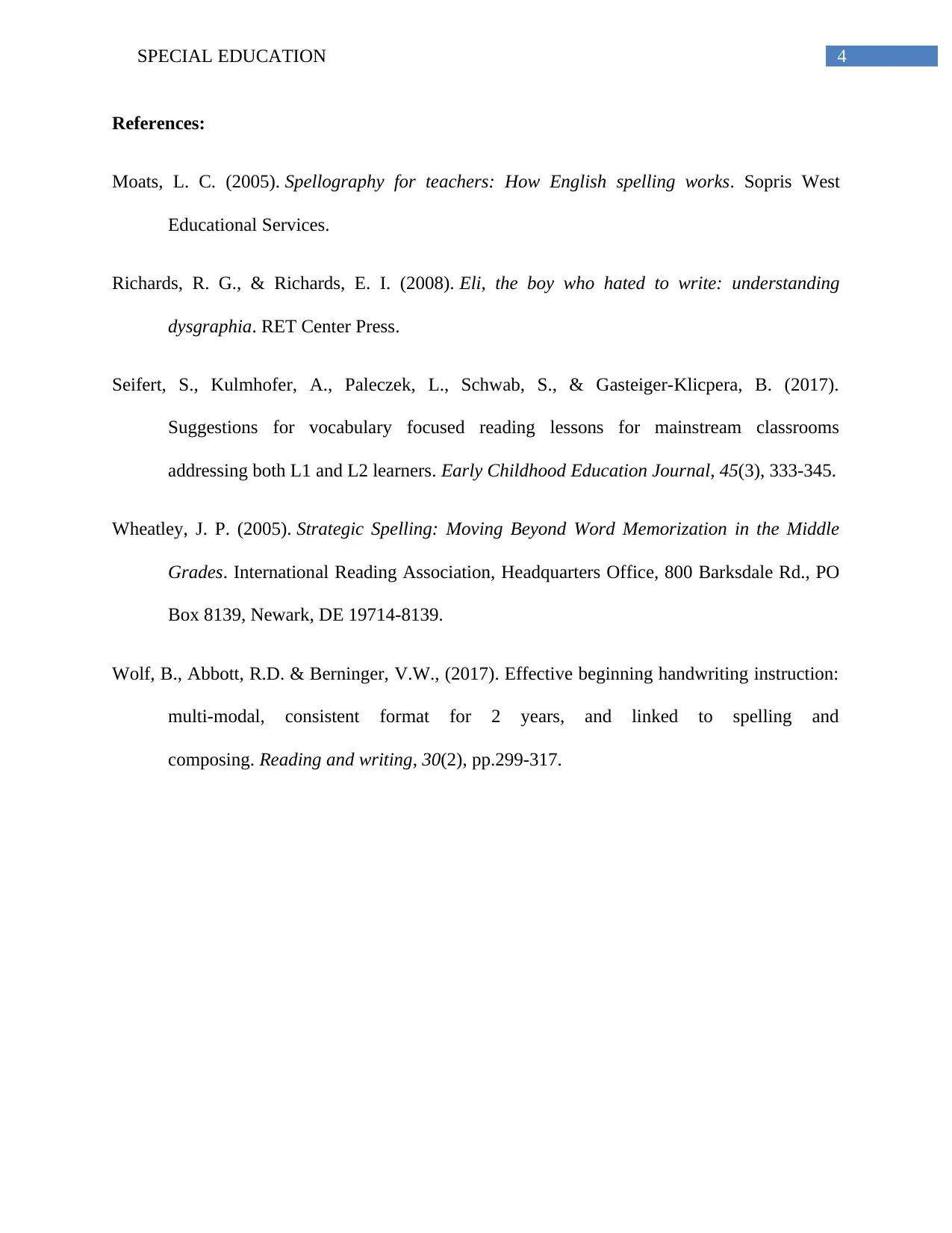
4SPECIAL EDUCATION
References:
Moats, L. C. (2005). Spellography for teachers: How English spelling works. Sopris West
Educational Services.
Richards, R. G., & Richards, E. I. (2008). Eli, the boy who hated to write: understanding
dysgraphia. RET Center Press.
Seifert, S., Kulmhofer, A., Paleczek, L., Schwab, S., & Gasteiger-Klicpera, B. (2017).
Suggestions for vocabulary focused reading lessons for mainstream classrooms
addressing both L1 and L2 learners. Early Childhood Education Journal, 45(3), 333-345.
Wheatley, J. P. (2005). Strategic Spelling: Moving Beyond Word Memorization in the Middle
Grades. International Reading Association, Headquarters Office, 800 Barksdale Rd., PO
Box 8139, Newark, DE 19714-8139.
Wolf, B., Abbott, R.D. & Berninger, V.W., (2017). Effective beginning handwriting instruction:
multi-modal, consistent format for 2 years, and linked to spelling and
composing. Reading and writing, 30(2), pp.299-317.
References:
Moats, L. C. (2005). Spellography for teachers: How English spelling works. Sopris West
Educational Services.
Richards, R. G., & Richards, E. I. (2008). Eli, the boy who hated to write: understanding
dysgraphia. RET Center Press.
Seifert, S., Kulmhofer, A., Paleczek, L., Schwab, S., & Gasteiger-Klicpera, B. (2017).
Suggestions for vocabulary focused reading lessons for mainstream classrooms
addressing both L1 and L2 learners. Early Childhood Education Journal, 45(3), 333-345.
Wheatley, J. P. (2005). Strategic Spelling: Moving Beyond Word Memorization in the Middle
Grades. International Reading Association, Headquarters Office, 800 Barksdale Rd., PO
Box 8139, Newark, DE 19714-8139.
Wolf, B., Abbott, R.D. & Berninger, V.W., (2017). Effective beginning handwriting instruction:
multi-modal, consistent format for 2 years, and linked to spelling and
composing. Reading and writing, 30(2), pp.299-317.
1 out of 5
Related Documents
Your All-in-One AI-Powered Toolkit for Academic Success.
+13062052269
info@desklib.com
Available 24*7 on WhatsApp / Email
![[object Object]](/_next/static/media/star-bottom.7253800d.svg)
Unlock your academic potential
Copyright © 2020–2025 A2Z Services. All Rights Reserved. Developed and managed by ZUCOL.



